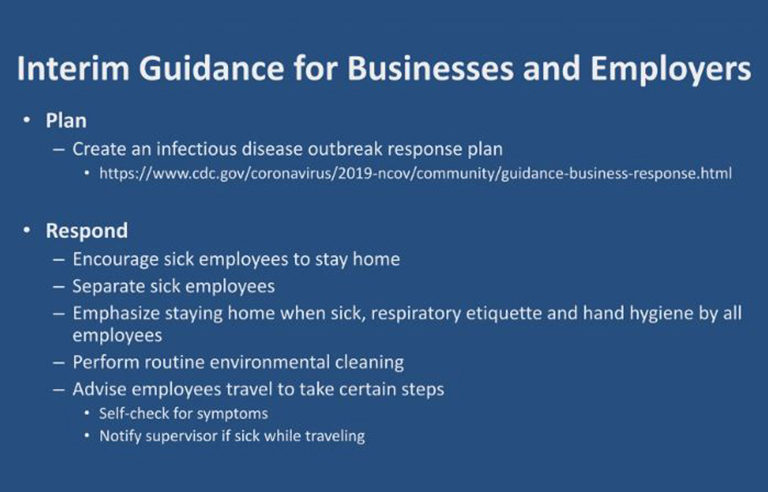COVID-19 pandemic: ‘Not too late’ to begin response planning, NIOSH director says

Washington — Employers looking for ways to protect their workers from exposure to the COVID-19 pandemic should adopt a team approach, according to NIOSH Director John Howard, who says that “it’s not too late” to develop a plan.
Howard was the featured speaker on a March 18 webinar – hosted by the National Safety Council in conjunction with NIOSH – that focused on the effects COVID-19 is having on businesses with domestic and global customers and partners. He told attendees, “You have to have a coronavirus response team at any workplace. Somebody’s got to be in charge of looking (online), finding new guidance and telling everybody what to do.
“You really need somebody doing that on a fairly constant basis, because this is a rapidly evolving situation. I would look at that as a crisis team. Clearly, your emergency response plan now has to be a coronavirus emergency plan.”
On March 11, the World Health Organization declared COVID-19 a global pandemic. The illness is reportedly linked to a large seafood and animal market in Wuhan, China, according to the Centers for Disease Control and Prevention. Symptoms include fever, cough and shortness of breath. In the United States and its territories, as of March 18, 7,038 people in all 50 states, the District of Columbia, Puerto Rico, Guam and the U.S. Virgin Islands had been diagnosed with the illness and 97 had died, the agency states.
Howard stressed the importance of a creating a team tasked with regularly checking updated guidance online from sources such as CDC, NIOSH and the Department of Labor.
“This is unprecedented,” he said. “Sometimes when we write things down, it becomes out of date in the next 10 or 15 minutes. … It’s not too late to do pandemic planning and response within any business right now because we’re going to be in this for a while.”
NSC offers numerous resources for employers at NSC.org/Coronavirus.
During the one-hour webinar, Howard responded to more than 20 questions from attendees, discussing a wide variety of topics, including:
Public interaction. For employers with workers who interact with the public, such as delivery drivers and customer service representatives, the coronavirus has caused a dilemma when it comes to social distancing – the practice of reducing close contact with others in an effort to help stop the spread of COVID-19, per guidance from CDC.
“This is a hard question,” Howard said. “Maintaining some kind of distance is important. To the extent that you can, you want to separate the staff and the customer.”
Providing workers with hand sanitizer and gloves, performing more surface cleaning, and perhaps putting a plastic or glass barrier between customers and staff are among Howard’s recommendations.
Return-to-work timeline. If a worker at any organization is infected by the coronavirus, determining the timeline for a return to work is still an unknown, Howard said.
“I’m not sure we know the answer to that yet,” he said. “Until we do, I think 30 days is a good period of time.”
Personal protective equipment. A nationwide shortage of respirators has caused concern, especially among frontline health care workers. Howard recommended two guidance documents:
- NIOSH’s Recommended Guidance for Extended Use and Limited Reuse of N95 Filtering Facepiece Respirators in Healthcare Settings
- CDC’s Strategies for Optimizing the Supply of N95 Respirators: Contingency Capacity Strategies
Howard said NIOSH is reconfiguring its website to include respirator resources on its homepage.
Guidance for utilities. Although water is not a harbor for the virus, Howard said sewage encountered by utility workers could pose a risk. “If you are that type of sewer worker, it’s important that you have personal protective equipment, including face protection,” he said.
| Sign up for Safety+Health's free monthly email newsletters and get the news that's important to you. |
Cleaning work surfaces. Cleaning and disinfecting work surfaces on a more regular basis – especially when a worker becomes ill – “is never a mistake,” Howard said.
Long-term pandemic. “Essentially, we’re trying to keep the infected people separated from the uninfected people,” he said. “A travel restriction is preventing infected people from coming into the country. Testing people to determine whether they’re positive, and then isolating them, is another example. Social distancing is another example.”
As for when the virus will be a thing of the past, Howard said, “It’s not clear yet. I think we have to adjust ourselves for the longer period of time rather than thinking, ‘Oh, this is going to be over next month.’”
Post a comment to this article
Safety+Health welcomes comments that promote respectful dialogue. Please stay on topic. Comments that contain personal attacks, profanity or abusive language – or those aggressively promoting products or services – will be removed. We reserve the right to determine which comments violate our comment policy. (Anonymous comments are welcome; merely skip the “name” field in the comment box. An email address is required but will not be included with your comment.)

